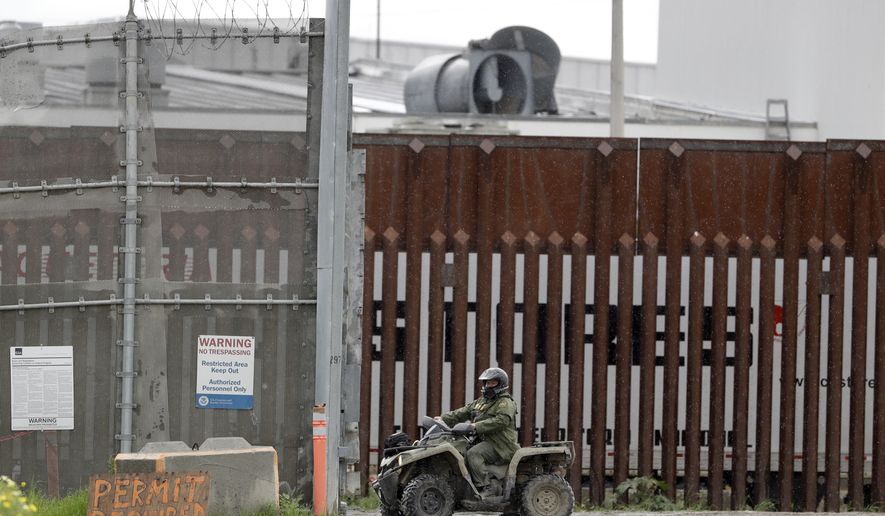The coronavirus has shut down much of the country, left Capitol Hill a ghost town and even sidelined aircraft carriers. But it hasn’t been able to dent construction of the border wall.
Since the virus was first detected on U.S. soil in January, the government has completed about 40 more miles of border fencing, according to Border Patrol data, with more than half of that coming since early February, about the time Mr. Trump announced a second wave of cash was being funneled from the Pentagon toward wall building.
Acting Homeland Security Secretary Chad Wolf, amid his virus duties last week, signed off on six waivers to speed wall construction in sections all across the boundary line, and contracts were announced for new segments of the wall.
“Border security is national security,” said Rusty Payne, a spokesman for Customs and Border Protection, who said construction remains on track to meet the target the president laid out. “We have completed 142 miles of new border wall system and we have another 197 miles under construction. In addition there are 414 miles in the pre-construction phase. We remain confident we will have 450 miles completed by the end of 2020.”
Brandon Judd, president of the National Border Patrol Council, said it makes sense to keep building.
“Today is not the time to play politics with the lives of U.S. citizens. Walls have proven to stop illegal entries into the United States, therefore they are an essential law enforcement resource which will undoubtedly help in reducing the spread of COVID-19,” he told The Washington Times.
Mr. Trump in several press conferences last week connected the wall to coronavirus.
“We’re up to over 150 miles of wall on our southern border, which is now turning out to be even more important than we originally thought. But I always thought it was very important having borders,” he said one day.
The next day he returned to the issue when asked whether the U.S. would join a global effort to reduce tariffs.
The president seemed to dismiss the idea, saying the U.S. has strong borders, and he wants to keep it that way.
“Before I came here, we weren’t into borders,” he said. “Now we’re up to almost 164 miles. Think of that: 164 miles of wall. Big, beautiful wall. And in those areas, it’s very, very tough to come in. We’ve been very tough on the borders. I mean, where we have the wall built, nobody is getting through. Now, they’re going around, but that’s a long trip. If they’re going around, that’s the way they get through.”
As of March 20, some 656 miles of the border now had a barrier — just two miles more than the 654 miles when Mr. Trump took office. But 128 of those miles have been upgraded from old dilapidated or outdated construction, and another 11 miles of secondary wall set back off the border have also been upgraded. One new mile of secondary wall has also been constructed.
Immigrant-rights activists, environmentalists and other Trump opponents have complained to top administration officials, saying the wall is a distraction amid the virus crisis — or, worse, a potential vector for its spread.
They point to California, where the governor has issued a “shelter in place” order instructing all residents not to go out unless they’re engaged in essential activities.
“In the border communities we represent, these extraordinary actions by the federal government are quite literally endangering the lives of border residents,” Tricia Cortez, executive director of the Rio Grande International Study Center, said in a statement joining other activists in opposing construction.
Some Trump opponents have called for him to return back to the Pentagon billions of dollars he’s siphoned away over the last two years to direct to wall-building.
Jay Field, a spokesperson for the U.S. Army Corps of Engineers, which is overseeing the construction effort, said they’re exempt from coronavirus shutdown orders because they are engaged in essential national security work, though they are taking the virus threat seriously.
“We are taking deliberate and prudent steps, following all government and CDC guidelines, to continue operations at the southern border,” the spokesperson said. “We are committed to fulfilling our responsibilities as a project-executing agency to help secure the nation’s southern border.”
The U.S. Army Corps of Engineers, which is overseeing the construction effort, didn’t respond to a request for comment on what justification it is citing for continued construction, though California’s shelter in place order specifically deems construction an essential service.
Even as wall construction continues, the Trump administration has taken steps to try to reduce the flow of people attempting to enter without authorization across the southwest border.
The Centers for Disease Control and Prevention triggered a part of public health law that the administration is using to immediately turn back illegal immigrants who show up at the border.
Mr. Wolf said in an interview with Fox News last weekend that it had cut unauthorized crossings by 50% in its first day.
• Stephen Dinan can be reached at sdinan@washingtontimes.com.




Please read our comment policy before commenting.